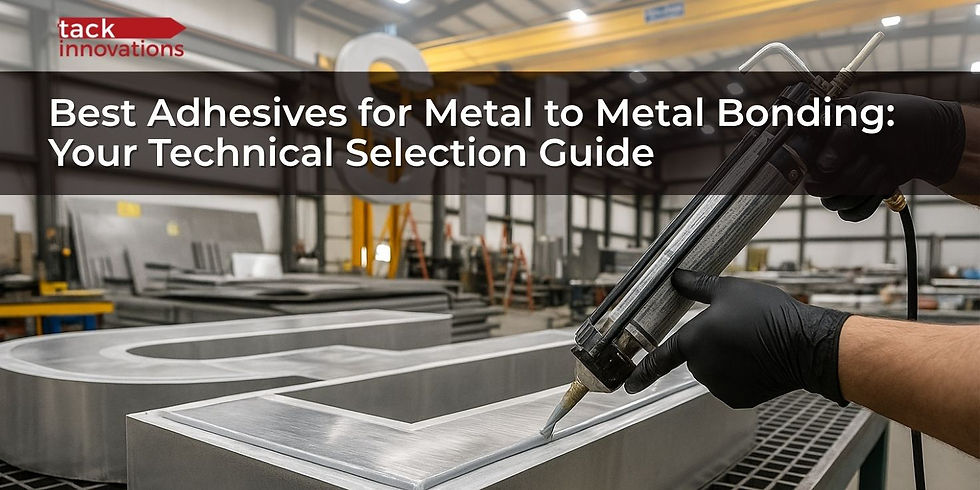Best Adhesives for Metal to Metal Bonding: Your Technical Selection Guide
- Tack Innovations
- Oct 24
- 4 min read

When designing or manufacturing with metal, achieving a strong, durable, and clean bond is paramount. While traditional methods like welding or mechanical fasteners have their place, modern structural adhesives offer superior stress distribution, corrosion resistance, and aesthetic quality for metal-to-metal applications.
If you are searching for the ultimate adhesive for metal to metal bonding, you need technical insight into the best products available.
What you will get from this guide:
Why adhesives are a high-performance alternative to traditional metal joining methods.
A look at the technical specifications of top-tier 3M™ Scotch-Weld™ Epoxies: DP190, DP100, 460NS, and 2214.
Cheat sheet for selecting the best adhesive based on your specific use case, including temperature, impact, and required work time.
Why Choose Epoxy Adhesives Over Welding?
If you work with metal fabrication, you know that joining parts is central to product design. While welding, screws, bolts, and rivets have been industry standards, structural adhesives offer a modern, high-performance alternative for metal-to-metal bonding, giving you more design freedom.
From improving aesthetics to enhancing performance, here is why adhesives are increasingly preferred:
Stress Distribution: Unlike fasteners that create single stress points, adhesives distribute the load and stress evenly across the entire bonded area. This eliminates stress concentration and improves the part's fatigue performance and overall durability.
Invisible Joints: Adhesives create a smooth, clean bond line, removing the need for visible screws or rivets and improving product aesthetics.
Sealing and Corrosion Resistance: A continuous adhesive layer not only bonds but also acts as a seal, preventing the entry of moisture or chemicals. This reduces the risk of corrosion, especially when joining dissimilar metals.
Lightweighting: Adhesives can replace heavy mechanical fasteners, contributing to weight reduction in the final product.
Best Adhesives for Metal-to-Metal Bonding
When bonding metal, epoxy adhesives are the industry standard for strength, durability, and versatility. Here are four high-performance 3M™ Scotch-Weld™ Epoxy Adhesives that are top-of-mind for metal applications:
3M™ Scotch-Weld™ Epoxy Adhesive DP100 Clear
Key Feature: Known for its rapid strength development and versatility. It offers high strength with a very short 5-minute work life.
Use Case: Ideal for small-part assembly and quick repairs where high strength is needed quickly and little to no time is available for part alignment. (Note: This product is a common, fast-setting rigid epoxy in the 3M line, mentioned in the product selection guide for metal bonding.)
3M™ Scotch-Weld™ Epoxy Adhesive DP190
Key Feature: Provides exceptional performance with high shear and peel strength. It is known for its extended 80 to 90-minute work-life, which is crucial for bonding large components or when precise alignment is needed.
Use Case: Excellent for jobs requiring an extended adjustment period or for applications needing a high degree of flexibility and elongation to absorb impact and vibration.
3M™ Scotch-Weld™ Epoxy Adhesive 460NS
Key Feature: A non-sag (NS), toughened epoxy with a 2:1 mix ratio. It delivers high peel and shear strength, is specifically formulated for impact resistance, and exhibits high fatigue resistance. It has a 60-minute work life, allowing for part adjustment.
Use Case: Recommended for applications subject to high dynamic stress, such as transportation (automotive, rail) or sporting goods, where a durable, high-impact bond is essential.
3M™ Scotch-Weld™ Epoxy Adhesive 2214
Key Feature: This is a one-part, heat-curing adhesive, meaning the chemical reaction only starts when heat is applied, offering the potential for longer open time before the cure. It has a pliable paste, non-sag consistency and is designed for high-temperature resistance (up to 250ºF / 121ºC).
Use Case: Ideal for aerospace, automotive, and industrial manufacturing applications where high strength is required at elevated temperatures and a one-part, pre-applied paste is preferred for smooth bond lines.
How to Choose the Right metal bond adhesive Based on Your Use case
Selecting the correct adhesive comes down to matching its key performance characteristics to the demands of your application. Consider the following factors:
Performance Characteristic | Why It Matters | Product Examples (See above) |
Work Life / Open Time (Assembly/Adjustment Time) | This is the time you have to apply the adhesive, mate the parts, and make adjustments before it begins to cure. For large assemblies or complex positioning, a longer work life is critical. | Long: DP190 (90 min), DP460NS (60 min) Short: DP100 (5 min) |
Toughness & Impact Resistance | If your final product will be subjected to vibration, shock, or high physical stress (e.g., sporting equipment, vehicle parts), you need a toughened adhesive that resists cracking and flexing. | Toughened/High Impact: DP460NS |
Temperature Resistance | For applications exposed to heat during use (e.g., electronics, engine components), a standard two-part epoxy may soften. Products specifically designed as "heat-cured" or "high-temperature" offer superior performance in these conditions. | High-Temperature: 2214 (up to 250ºF) |
Viscosity and Flow | Viscosity defines the adhesive’s thickness. Non-sag (NS) pastes are thick and stay in place on vertical surfaces, whereas flowable/self leveling liquids are better for filling gaps or potting enclosures. | Non-Sag Paste: 460NS, 2214 Medium Viscosity Liquid: DP190 |
Get Expert Advice from Tack Innovation
The details of your specific metal substrate (e.g., aluminium, stainless steel) and the exact environmental conditions of your application can significantly influence adhesive choice.
Tack Innovation is an authorised 3M distributor with deep technical experience in structural bonding solutions. To ensure you select the optimal product and process for your design and manufacturing requirements, we recommend speaking with an application engineer.
Click here to Book a call with a Tack Innovation Expert



Comments